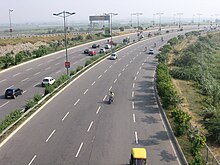
Back भारत के एक्सप्रेसवे Bihari ভারতের এক্সপ্রেসওয়ে Bengali/Bangla ભારતીય એક્સપ્રેસમાર્ગો Gujarati द्रुतमार्ग (भारत) Hindi Jalan tol di India ID भारतामधील द्रुतगतीमार्ग Marathi ଭାରତର ଏକ୍ସପ୍ରେସୱେ ସମୂହ OR Expressways of India SIMPLE இந்திய விரைவுவழி Tamil భారతదేశపు ఎక్స్ప్రెస్వేలు Tegulu
Expressways are the highest class of roads in India. As of December 2024, the total length of expressways in India was 6,059 km (3,765 mi), with 11,127.69 km (6,914.43 mi) under construction. As per NHAI and Indian Roads Congress, expressways are access controlled highways with a divided carriageway, designed for high speed vehicular movement and heavy traffic.[1] There is a central reservation or median that separates the flow travelling in opposite directions. Entrance and exits are provided only by grade separated interchanges. The interchanges may be system interchanges (such as cloverleaf, three-way, trumpet) used with other national or state highways or be service interchanges (such as SPDI) used with smaller roads.[2] In contrast, National highways may or may not be divided by a median and may or may not have access control.[3] Some highways, built by State Governments, which may be fully access controlled or may be limited access controlled, are declared or named as expressways by their respective State Governments.[4]
| Expressways of India | |
|---|---|
 | |
| System information | |
| Maintained by Ministry of Road Transport and Highways | |
| Length | 6,059 km (3,765 mi) |
| Formed | 2002 |
| Highway names | |
| System links | |



As of 2024, the longest expressway in India is the partially-opened Delhi–Mumbai Expressway (Phase-III) at 1,015 km (631 mi), which was opened in December 18, 2024,[5] and the widest expressway is the Delhi – Gurgaon section of the Dwarka Expressway with 16 lanes, which was opened in 2024.
- ^ https://tis.nhai.gov.in/UploadGazatte/gazatte_notification.pdf
- ^ https://law.resource.org/pub/in/bis/irc/irc.gov.in.sp.099.2013.pdf
- ^ https://www.indiacode.nic.in/bitstream/123456789/1651/1/AAA1956____48.pdf
- ^ https://nhai.gov.in/assets/pdf/highway%20rating%20notice-with%20Attachements.pdf
- ^ https://timesofindia.indiatimes.com/city/jaipur/80km-route-of-del-mum-eway-opens-to-boost-connectivity/articleshow/116412281.cms